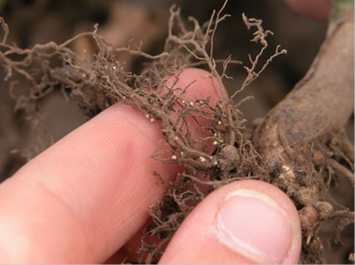While it has been commonly found in southwestern Ontario since 1988, the soybean cyst nematode (SCN) first appeared in Québec in 2013. SCN is one of the parasites causing the most damage to soybean crops in the world and can lead to a yield loss of up to 30% without visible symptoms being exhibited. While impossible to eradicate, the disease can still be controlled through testing and the implementation of best crop management practices to limit the spread and active reproduction of the parasite.

What are the symptoms?
The various signs of SCN infestation generally appear two months after seeding. The symptoms are:
- White, yellow or brown cysts on the secondary roots (visible to the naked eye);
- Chlorosis (leaf yellowing);
- Round yellow patches in the field along the tillage direction;
- Stunting;
- Reduced number of side roots;
- Reduced nodulation of the soybean;
- Canopy slower to cover the space between rows;
- Early maturity of certain zones;
- Yield loss;
- Plant death (in extreme cases).
How to detect SCN?
Cyst population density is at its highest when soybean plants are fully mature. Testing for SCN should be performed at plant maturity or immediately after harvesting. However, the absence of cysts on a plant doesn’t mean there are no parasites in the field. For this reason, it is recommended to analyze the soil and roots in at-risk soybean fields in the fall. A field is deemed at risk if:
- It shows one or many of the symptoms listed above;
- Soybean has been grown as a monoculture for at least three consecutive years;
- Contract work is often performed;
- There is significant weed presence;
- The field is located near another field where SCN was detected.
Sampling > Collect 25 soil samples from the root zone with a probe or an auger. Mix the samples and collect 1 litre of the mixture to create a representative sample. Send this sample to the MAPAQ’s Laboratoire d’expertise et de diagnostic en phytoprotection (LEDP) or any Ontario soil laboratory that tests for SCN.
What should you do if SCN is detected?
It is advised to rotate crops with a non-host crop such as corn, wheat or non-susceptible soybean varieties such as Rico R2X and Nano R2X and purchase seeds that were treated against SCN. SCN can be spread by the wind, birds and soil transportation. Cleaning machines and equipment, as well as screening guests is also advisable. Infested fields must also be harvested or seeded last.
What’s the situation?
At the moment, SCN is fortunately not an issue in Québec, but we must remain cautious in the future. Let’s not forget that waterhemp was introduced in the province through soil residues on used equipment coming from the United States. We must be vigilant if we don’t want the same thing to happen with SCN!
